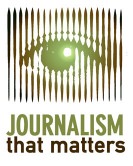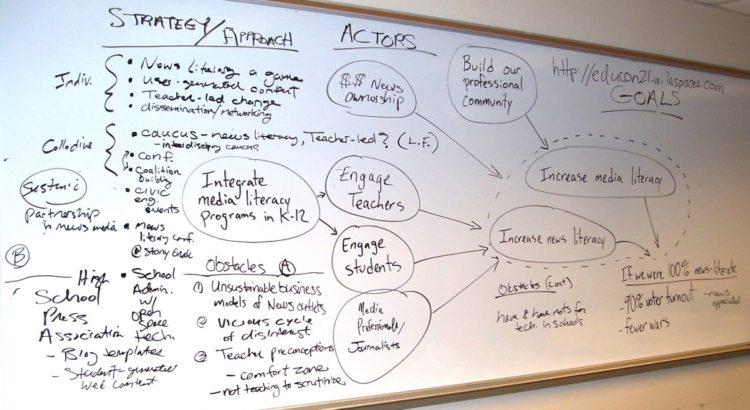DOCUMENTING “REBOOTING THE NEWS”
This is the home page for the “Rebooting the News” conference held Oct. 23-25, 2008, at the National Constitution Center and Temple University in Philadelphia. We have posted links to resources, photos and reports produced by participants, and links to their related projects. If you have updates to a project underway, email information to jtm@mediagiraffe.org.
Active resources
- A new study by Reboot participant Paul Mihailidis finds media-literacy programs don’t always teach the critical role of the press. (LEARN MORE)
- Participant Frank Baker is building a resource page of STATE CURRICULUM FRAMEWORKS
- Participants are joining and collaborating on THE REBOOTING SOCIAL NETWORK SITE
- Kristin Hokanson’s analysis: What are the critical skills?
LIVE BLOG/ARCHIVED RECORDINGS (from Kristin Hokanson)
Text reports
- Participant Lena Consolini’s School Library Journal article on “Rebooting the News”
- More than 20 “Rebooting” participants signed a consensus statement on the need for news literacy.
- LINKS TO BREAKOUT SESSION REPORTS
- Ideas about Best possible outcomes
- Our brainstorming cafe session report
- Defining news literacy (and link to Schneider talk)
- Saturday morning session notes
Video streams
Participant Kristin Hokanson documented much of our work in low-resolution video available for streaming or download from UstreamTV.
Photo galleries
- Participant Fabrice Florin loaded a SLIDE SHOW of our activity / (or view individually
- Flickr tagging of Reboot event posted signs / view as SLIDE SHOW.
- Flickr tagging of Reboot white boards/ view as SLIDE SHOW.
- View the WHOLE SET OF REBOOT PHOTOS/ view as a SLIDE SHOW
- View Jiwon Koon’s Picasa photo set (lots of group shots)
Pre-event pages
Other resources
- Here is the program schedule for the event
- FOLLOW THE TWITTER STREAM
- BLOG UPDATES
- Fabrice Florin’s NewsTrust Powerpoint (zip file)
- Fabrice Florin’s NewsTrust Powerpoint (as PDF slides)
What are you doing?
If you have posted a blog or story about “Rebooting the News,” please let us know by email to jtm@mediagiraffe.org . . . we’d like to link back to you.
And tell us what you’re doing in your domain to increase public interest in news literacy.
In spring 2005, the Carnegie Corporation of New York commissioned noted U.S. editor Merrill Brown to write a report, “Abandoning the News,”which examined how the nation’s news organizations, struggling with changing business models and demographics, were devoting fewer and fewer resources to newsrooms. But Brown also saw the problem as one of demand, not just supply, when he wrote:
“In short, the future of the U.S. news industry is seriously threatened by the seemingly irrevocable move by young people away from traditional sources of news.”
Indeed, American teen-agers are abandoning traditional news products in large numbers, or simply failing to engage with the “news” as they mature. In homes and classrooms, students are failing to receive the information they need to make informed decisions as voters and citizens. Yet they are highly engagedwith “media” in multiple forms.
Over the last three years, some foundations and institutions have recognizing the significance of these changes on participatory democracy. They have launched new researchor curriculum initiativesaimed at assessing or improvingthe situation.
This year, the American Society of Newspaper Editors (ASNE) adopted news literacy as a critical focus for its membership. Stony Brook University’s journalism of school is pioneering curriculum projects and plans a major conference in March, 2009. Together, Carnegie and the John S. and James L. Knight Foundation have committed $11 millionto develop a new approach to journalism teaching at the college level.
At “Rebooting the News,” we will observe and learn about these initiatives in the newsroom and the college classroom, but focus more particularly on the relationship between the news and K-12 education. Is it time to reconsider how America’s schools engage young adults in our civic sphere, and how can the Internet, news — and journalism — help?
We’ll build new connections, tap and energize the emerging consensus for a deeper relationship of shared aims, values and beliefs among America’s journalists and educators. Both have a vital interest in teaching youth to be smart consumers — and creators — of civic media.
Rebooting the News: Reconsidering an Agenda for American Civic Education
To assist these efforts an invited group of up to 60 journalists, researchers, scholars, educators, teachers, administrators, policy makers and leaders of non-profit and cultural organizations will convene Oct. 23-25, 2008, in the cradle of American democracy — Philadelphia — for “Rebooting the News: Reconsidering an Agenda for American Civic Education.”
Meeting at Temple University, we intend to:
- Learn about the ASNE initiative
- Prepare for the major March 2009 convening at Stony Brook
- Share knowledge about independent projects and research
- Examine “best practices” in teaching about the news media to K-12 and higher education students
- Review competing or parallel news/media-literacy paradigms
- Assess the role of news and news organizations in solutions
- Consider the value of new national policy strategies
- Adopt recommendations for journalists and educators
EXPECTED OUTCOME
“Rebooting the News: Setting an Agenda for American Civic Education,” is a critical examination of the relationship among media, news and U.S. public education, the projects underway and a charting of the most promising directions. Our goal is ideas and recommendations distilled into a post-event report for rebooting the news — making its presentation and content relevant both to a new generation and to democracy’s requirement for an informed, engaged electorate.
Identifying assumptions and best practices

At part of “Rebooting the News,” we’ll identify assumptions that underlie programs in news literacy, take a close look at “best practices” at the heart of such programs, and identify the kinds of research questions that are emerging as this work moves forward. For example, do the steeply declining rates of news readership suggest that people find traditional approaches to news presentation less relevant to their needs for monitoring and participating in their communities, nations and world?
Location, co-conveners
Temple University’s Media Education Laboratory, founded by Renee Hobbs,will host this knowledge-sharing, review, assessment and solution planning in partnership with the The Media Giraffe Projectat the University of Massachusetts-Amherst, the National Constitution Center, the Reynolds Journalism Institute at the Missouri School of Journalism and other co-convenors. We’ll use Temple’s facilities in Center City just blocks from Independence Hall. Over an afternoon, evening and two days, we’ll use a combination of short presentations, round-table discussions and “open-space” breakout sessions organized by participants. We’ll include lots of time for information networking and mini projects. We’ll learn about ASNE’s initiatives and capacities, and learn about Stony Brook’s early spring gathering.

Journalism That Matters

Reynolds Journalism Institute
Among other co-conveners:
- The American Society of Newspaper Editors
- The Journalism That Matters collaborative/ (hosted by the Media Giraffe Project)
- The New Media Literacies project at MIT, Cambridge, Mass.
- The News Literacy Project, Bethesda, Md. (formerly Appleseed)
- The Reynolds Journalism Institute at the Missouri School of Journalism, Columbia, Mo.
- Kent State University School of Journalism and Mass Communication
WHAT WE’LL CONSIDER (draft program)
Some of the things we expect “Reboot the News” to consider:
*Assessing the value of student-created media
New media forms, such as YouTube, present significant evolving uncertainties about trust, sourcing and reliability which magnify the need to offer students skills to access, analyze, evaluate, and produce media. Ideas about adding new media to the classroom are widely available, but little research exists on how media are used, or about the pedagogical value of media works created by students with civic purpose. How can we best promote interest in news and current events as well as critical analysis and evaluation skills among young people and non-journalists?
*Testing without civic component — undermining frameworks?
Many states have civics education requirements as part of the curriculum. They include valuable basic instruction on government such as the Constitution, the balance of powers, and how a bill becomes a law. Some state curriculum frameworks also encourage media-literacy education. However, is the growing reliance on “teach-to-the-test” — where test questions don’t cover civics or news literacy — made such frameworks irrelevant?
*The role of Web 2.0 and social media for civic engagement, journalism and education
Bloggers, social media groups and new online learning technologies are reshaping journalism and education. We’ll reflect upon the opportunities and challenges associated with the many new ways that these new technological resources reshape our work as journalists and educators.
*Using news as a frame for core curriculum — does it work?
Often on an ad hoc basis, many of America’s best teachers find ways to use current-event news materials in the classroom to illustrate curriculum points in history, social studies or literature. What work is underway to help them, and does this approach produce more engaged citizens? What approaches work best in introducing secondary-school teachers to integrating news and current events along with news analysis and production activities across the curriculum?
*Using journalists to address two challenges?
With students engaged in online activities at unprecedented levels . . . their access to media is almost unlimited . . . they have moved from primarily web searching to media creation sites such as Facebook, YouTube and MySpace. To engage students in understanding current events it must be on this broad media playing field. Few classroom teachers have both the journalism skills and the media tools to help students become engaged in creating their own media. Can journalists become allies with teachers in this effort? What will be the impact on the survival of the news business?
A collaboration of teachers and journalists could change how our schools prepare teen-agers for media use in a civil society, and address two key challenges:
*How to elevate in the minds of school boards and state curriculum framers the importance of media-literacy education as a core element of preparing teen-agers to be informed, engaged citizens.
*In an environment of little-or-no financial resources, how to offer teachers the tools and training they need to be able to work with new-technology media resources alongside increasingly media-savvy (but not necessary news-savvy) students.
WHAT IS NEWS LITERACY?
NOTES ON August Poynter summit on news literacy
What is news literacy? It’s considerably broader than the field of journalism education, where young people get a professional orientation to the field as a means to consider career opportunities. News literacy aims to address the needs of all young people, preparing them to be citizens who use news and information to guide their decision-making in all aspects of their lives. News literacy emphasizes the ability to “read between the lines” to recognize implicit or subtext messages. The messages are thought to reveal values expressed in news.
News-literacy education prepares young people to be citizens by helping them develop an interest in news and current events, stimulating the skills to critically analyze the messages they receive, and inspiring the self-efficacy needed to use information to make effective decisions and take action in their schools, communities and the wider world. There are several different models for news literacy programs and each approach the practice with a unique set of assumptions, goals, and strategies for educating youth.
One of the fundamental concepts in media literacy comes from the work of cultural studies scholar Raymond Williams, who defined the practice of various “reading positions” toward cultural texts, including dominant, negotiated and oppositional readings. Scholars in the field debate: What does it mean to teach people how to “read” news and journalism from a dominant, negotiated or oppositional frame?


